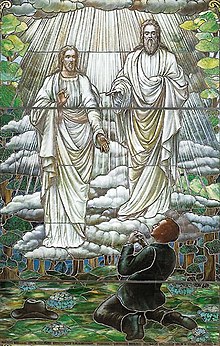
Back Primer Visión AST Fas Visen Bislama Erste Vision German Unua Vizio (mormonismo) Esperanto Primera Visión Spanish Ensimmäinen näky Finnish Unesma Viziono IO Prima Visione (mormonismo) Italian 最初の示現 Japanese Purmeira Bison MWL

The First Vision (also called the grove experience by members of the Community of Christ) refers to a theophany which Latter Day Saints believe Joseph Smith experienced in the early 1820s, in a wooded area in Manchester, New York, called the Sacred Grove. Smith described it as a vision in which he received instruction from God the Father and Jesus Christ.
According to the account Smith told in 1838, he went to the woods to pray about which church to join but fell into the grip of an evil power that nearly overcame him. At the last moment, he was rescued by two shining "Personages" (implied to be God the Father and Jesus) who hovered above him. One of the beings told Smith not to join any of the existing churches because they all taught incorrect doctrines.
Smith wrote several accounts of the vision between 1832 and 1842, two of which were published in his lifetime.[1] Consistency of the accounts is a subject of debate, whether variations are indicators of significant shifts in Smith's theology or are simply changing emphasis of minor details.[2][3] The First Vision is revered in Latter-day Saint theology as the first step in the Latter Day Saint restoration, but it was relatively unknown to early adherents to the Latter Day Saint movement;[4] Smith's experience was published in 1842 and canonized in 1880 but not emphasized in the Church of Jesus Christ of Latter-day Saints (LDS Church) until the early 20th century.[5] For Latter-day Saints, the First Vision corroborates distinctive doctrines such as the bodily nature of God the Father and the uniqueness of the Restored Gospel of Jesus Christ as the only true path to exaltation.[6]
- ^ "First Vision Accounts", churchofjesuschrist.org, The Church of Jesus Christ of Latter-day Saints
- ^ James B. Allen, "The Significance of Joseph Smith's 'First Vision' in Mormon Thought,"] Dialogue: A Journal of Mormon Thought 1 [Autumn 1966]:42-43
- ^ Dan Vogel, "The Earliest Mormon Concept of God," in Gary James Bergera, ed., Line upon Line: Essays on Mormon Doctrine (Salt Lake City: Signature Books, 1989), 17-33.
- ^ James B. Allen, "The Significance of Joseph Smith's 'First Vision' in Mormon Thought." Dialogue: A Journal of Mormon Thought, Vol. 1 No. 3 (1966): 29–46.
- ^ (Flake 2003, p. 84) ("The First Vision changed the arena of confrontation over differences from social action to theological belief, a necessity created not only by the experience of persecution but also by Supreme Court law .... New emphasis on the First Vision successfully reframed the Latter-day Saints' necessary sense of otherness so that it fit safely within the politics of American religion. Unlike his teachings on plural marriage, Joseph Smith's First Vision placed his followers at odds only with other churches, not the state, and shifted the battle from issues of public morality to theological tenets.")
- ^ "Lesson 3: 'I Had Seen a Vision'", Doctrine and Covenants and Church History Gospel Doctrine Teacher's Manual, LDS Church, 1999, p. 11; Widmer 2000, p. 92: "The concepts of the apostasy of Christianity, God having a body of flesh and bone, the existence of a plurality of Gods, and the divine call of Joseph Smith as Prophet all have their foundation in the First Vision story."
© MMXXIII Rich X Search. We shall prevail. All rights reserved. Rich X Search